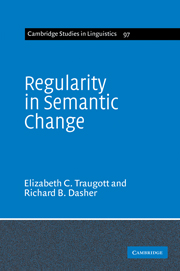
-
Select format
-
- Publisher:
- Cambridge University Press
- Publication date:
- September 2009
- December 2001
- ISBN:
- 9780511486500
- 9780521583787
- 9780521617918
- Dimensions:
- (228 x 152 mm)
- Weight & Pages:
- 0.7kg, 362 Pages
- Dimensions:
- (228 x 152 mm)
- Weight & Pages:
- 0.53kg, 364 Pages
You may already have access via personal or institutional login
Book description
This important study of semantic change examines how new meanings arise through language use, especially the various ways in which speakers and writers experiment with uses of words and constructions in the flow of strategic interaction with addressees. There has been growing interest in exploring systemicities in semantic change from a number of perspectives including theories of metaphor, pragmatic inferencing, and grammaticalization. Like earlier studies, these have for the most part been based on data taken out of context. This book is a detailed examination of semantic change from the perspective of historical pragmatics and discourse analysis. Drawing on extensive corpus data from over a thousand years of English and Japanese textual history, Traugott and Dasher show that most changes in meaning originate in and are motivated by the associative flow of speech and conceptual metonymy.
Reviews
'How does it come about that linguistic expressions change their meanings over time, or, to be more precise, that speakers start using established linguistic expressions with novel meanings? What is the nature of semantic change, and - more importantly - can we generalize about different instantiations of semantic change not only within individual languages but also cross-linguistically? The book under review, by Elizabeth Closs Traugott and Richard B. Dasher, provides bold answers to such big questions.'
Source: Journal of Linguistics
Contents
Metrics
Altmetric attention score
Full text views
Full text views help Loading metrics...
Loading metrics...
* Views captured on Cambridge Core between #date#. This data will be updated every 24 hours.
Usage data cannot currently be displayed.
Accessibility standard: Unknown
Why this information is here
This section outlines the accessibility features of this content - including support for screen readers, full keyboard navigation and high-contrast display options. This may not be relevant for you.
Accessibility Information
Accessibility compliance for the PDF of this book is currently unknown and may be updated in the future.


